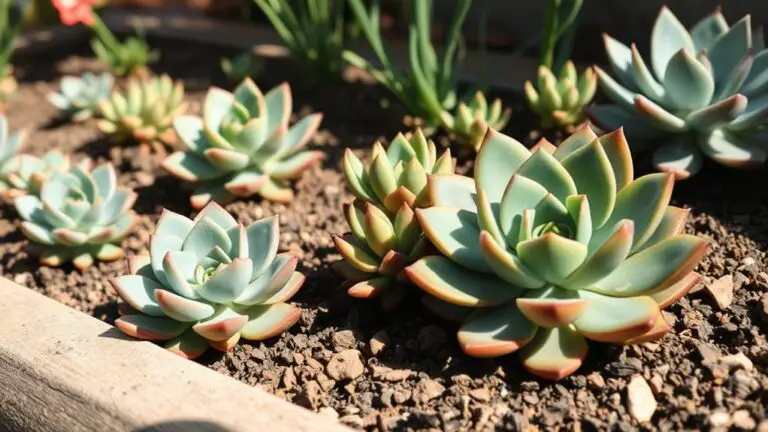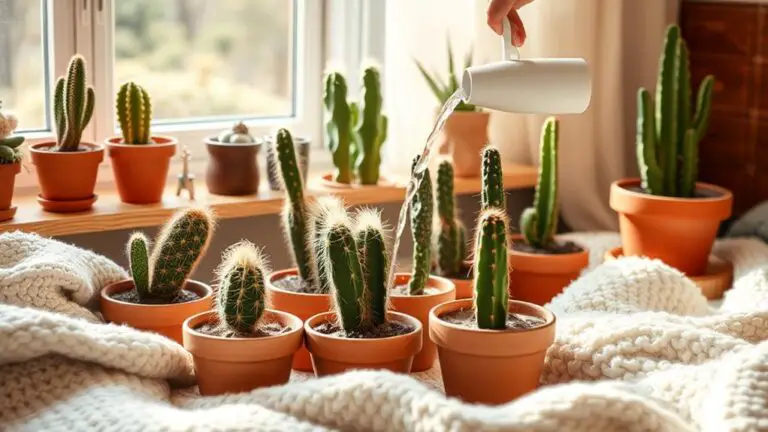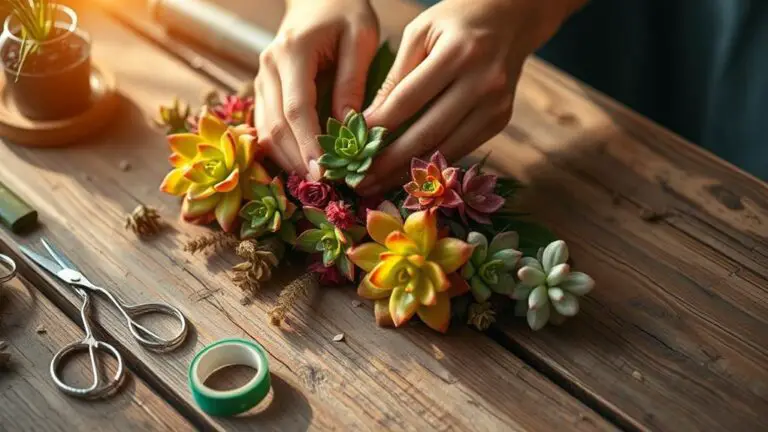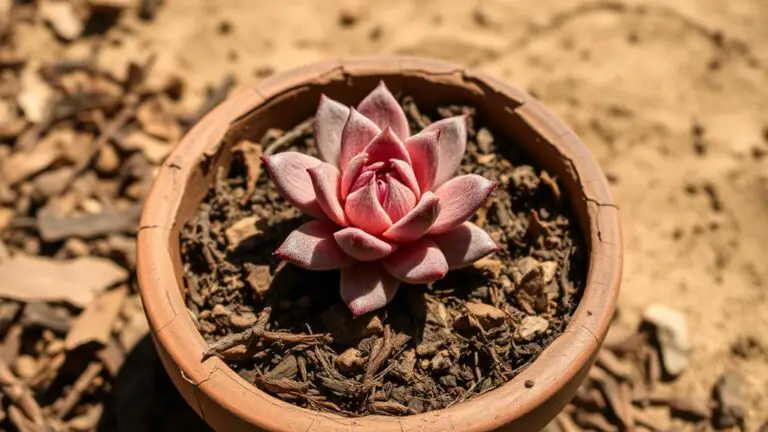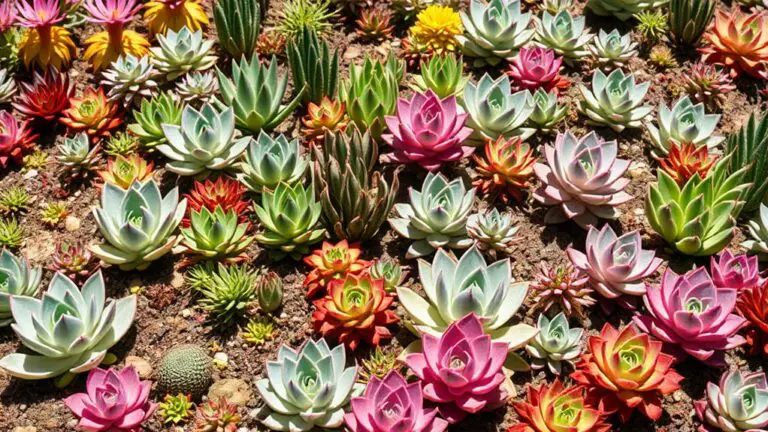Identifying and Treating Root Nodules in Succulents
When you're caring for succulents, identifying and addressing root nodules is essential for their well-being. Healthy root nodules are firm and uniformly colored, but if you notice discoloration or swelling, it may signal problems like nematode infestations. You'll need to trim affected roots with sterilized tools, rinse the plant, and let it heal in a well-ventilated area before replanting. But how can you be sure it's just a nodule issue and not something more severe? Understanding the differences and knowing the right steps can make all the difference in your succulent's health.
Understanding Root Nodules
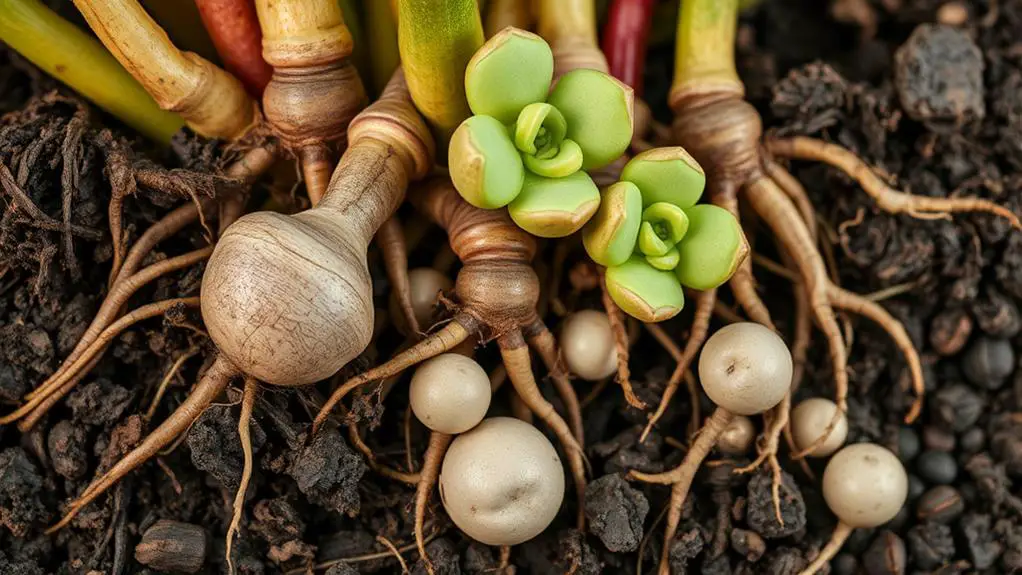
Root nodules are fascinating structures that form on the roots of certain plants, especially legumes, due to a symbiotic relationship with nitrogen-fixing bacteria called rhizobia.
These nodules act as tiny homes for the bacteria, which convert atmospheric nitrogen into forms that the plants can use. This process enhances nutrient absorption, making it easier for the plants to grow healthy and strong.
You might wonder how these root nodules look. Well, their appearance can vary by plant species. They often show up in colors like pink, yellow, or white. Healthy nodules are typically firm and rounded, indicating good plant health.
While root nodules are more common in legumes, some succulent varieties in the legume family can form them too.
Understanding root nodules is vital for maintaining your plants' health. They play a significant role in the nitrogen cycle, helping plants thrive even in nutrient-poor soils. This means your plants can grow better and contribute to improving soil fertility.
If you notice abnormal nodules, it might indicate stress or infections, so it's important to keep an eye out for these signs. By understanding root nodules, you can guarantee your plants stay healthy and vibrant.
Role of Root Nodules
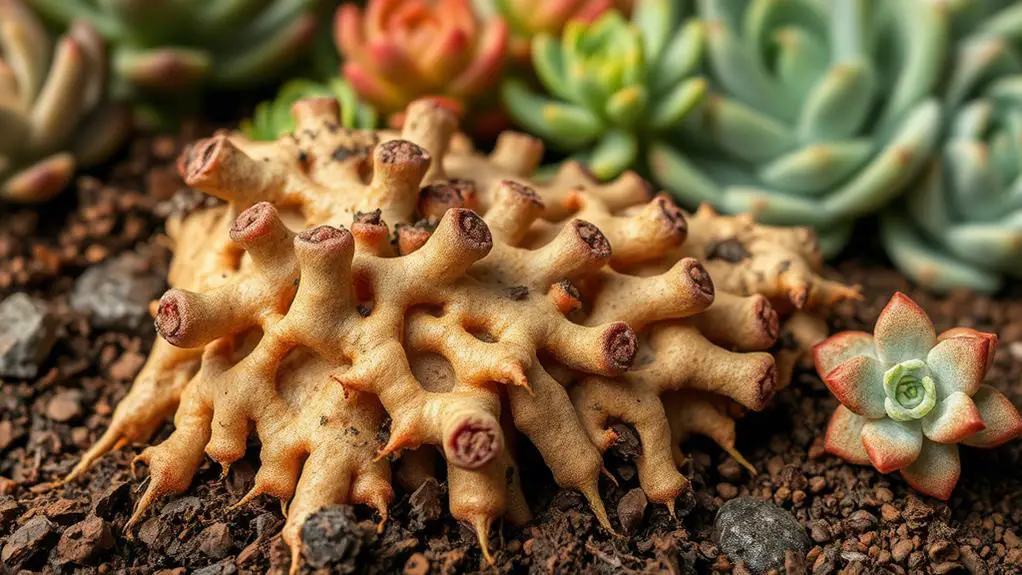
Understanding the role of root nodules is fundamental for anyone looking to maintain healthy succulents. Root nodules are specialized structures formed in a symbiotic relationship with nitrogen-fixing bacteria. This relationship is key for nutrient absorption, particularly nitrogen, which is vital for your succulents' growth.
By converting atmospheric nitrogen into forms that succulent roots can absorb, root nodules enable these plants to thrive in nutrient-poor soils.
Healthy root nodules are firm and consistently colored, showing a successful symbiotic relationship. Unhealthy ones, on the other hand, may be discolored or swollen, indicating stress or disease.
Environmental factors like soil moisture and pH can influence the formation and health of these nodules. Ensuring these conditions are ideal will help your succulents develop and maintain healthy root nodules.
While root nodules are more common in legumes, certain succulent species can also develop them, although less frequently. This adaptation helps address their unique nutrient acquisition needs.
Root Nodules in Succulents
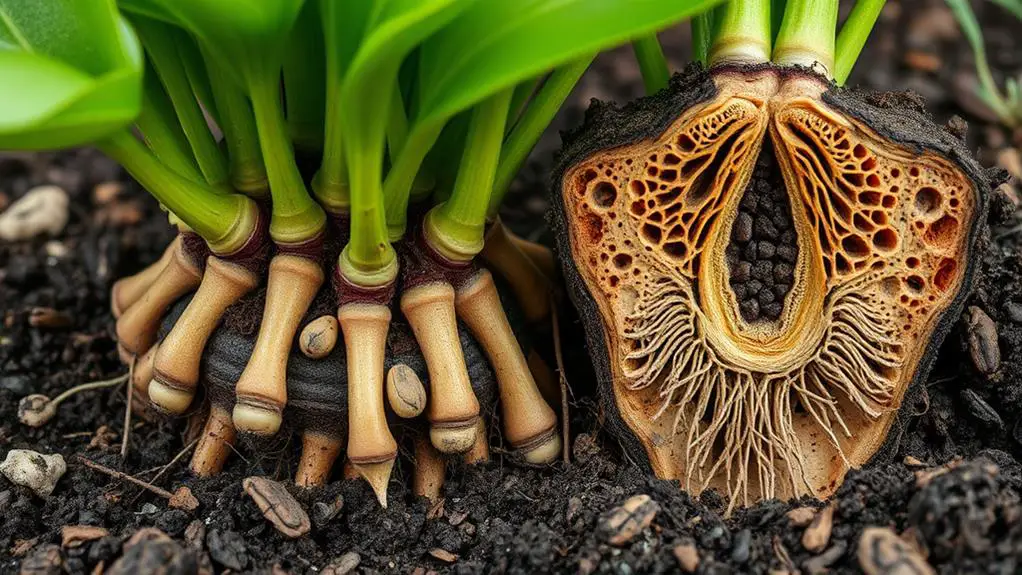
You might find it surprising, but root nodules do occur in some succulent species, although they're relatively rare. These nodules are mostly found in succulents within the legume family. Healthy root nodules are typically firm, rounded, and consistently colored. However, unhealthy nodules may show signs of discoloration, swelling, or stunted growth, which can indicate stress or potential issues like root rot or nematode infestations.
| Healthy Nodules | Unhealthy Nodules |
|---|---|
| Firm | Discolored |
| Rounded | Swollen |
| Consistently colored | Stunted growth |
| Indicator of good health | Sign of stress or infection |
Monitoring root nodules during repotting is essential for maintaining plant health. Regular checks help you catch problems early. Over-fertilization can cause nutrient imbalances, so be cautious with fertilizers. Unlike legumes, succulents generally don't need extra nitrogen fertilizers. They absorb nutrients from the soil or through their leaves.
If you notice abnormal nodules, take action immediately. Inspect the roots for pests or rot to prevent further damage. Remember, proactive care is the key to keeping your succulents thriving. By understanding root nodules and monitoring them, you can guarantee your plants stay healthy and vibrant.
Identifying Healthy Nodules
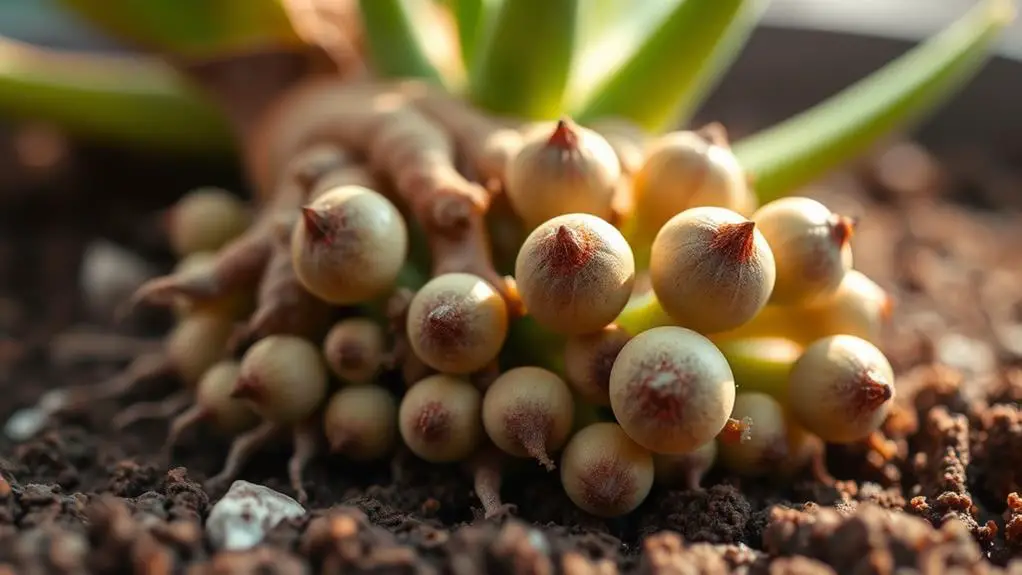
To identify healthy root nodules, check for firm, plump, and consistently colored bumps on the roots, which show a good relationship with nitrogen-fixing bacteria.
These nodules can be pink, yellow, or white, depending on the succulent species.
Regularly inspect the root system, especially during repotting, to make sure the nodules are healthy and doing their job in helping your plant absorb nutrients.
Color and Firmness
When examining root nodules in succulents, firm and rounded shapes are reliable indicators of health and a thriving symbiotic relationship with nitrogen-fixing bacteria.
Healthy root nodules often show consistent color and firmness. The color can vary with the plant species, displaying shades of pink, yellow, or white. This variety is normal, but you should look for uniformity in color and firmness.
If you notice any changes or abnormalities, like discoloration or unusual swelling, these might signal stress or disease. Healthy nodules contribute notably to the plant's nitrogen acquisition, so any sign of trouble shouldn't be ignored.
Regular monitoring of your succulent's root nodules is essential. It helps you catch any potential issues early and guarantees your plant remains healthy.
Consistency in the appearance of the nodules is a good sign. However, if the nodules become too firm or change color, it might indicate an underlying problem.
In such cases, a closer inspection of the plant and its root system is needed. By staying vigilant and attentive to these signs, you can help your succulents thrive and maintain their vibrant health.
Nodule Location Check**
Spotting healthy root nodules starts with a thorough nodule location check.
Begin by gently removing the succulent from its pot, being careful not to cause stress or damage to the roots. Look closely at the root system, focusing on the root hairs. Healthy root nodules are typically firm, rounded swellings found near these areas.
Check the nodules' color. Depending on the plant species, they might be white, pink, or reddish-brown. Consistent coloration and a plump appearance are good signs. These healthy nodules indicate a successful symbiotic relationship with nitrogen-fixing bacteria, which is vital for nutrient absorption, especially nitrogen, essential for your succulent's growth and development.
During repotting, always take the time to inspect the nodules. Regular monitoring helps you spot any signs of stress or damage early.
If the nodules look shriveled or discolored, it could mean there's an issue, such as poor soil conditions or a lack of proper care.
Symptoms of Unhealthy Nodules
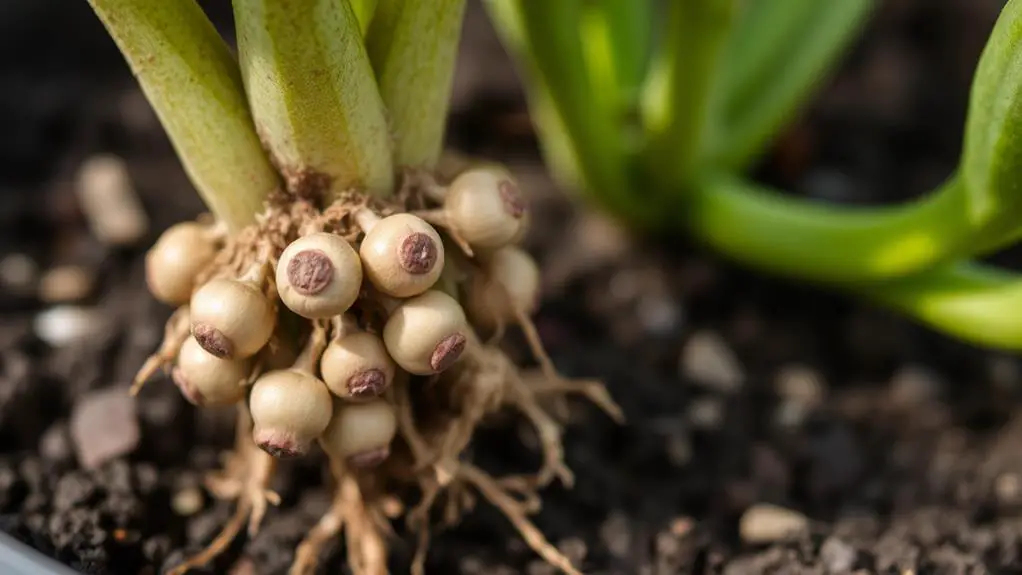
Many symptoms can indicate unhealthy root nodules in succulents, ranging from discoloration and swelling to irregular shapes. When root nodules aren't healthy, you might notice your succulent's growth slowing down.
This stunted plant growth often goes hand in hand with yellowing leaves, which can indicate poor nutrient absorption. These signs mean your plant is struggling to get the nutrients it needs from the soil.
To help you spot these issues, here are three key symptoms to watch for:
- Discolored or Swollen Nodules: Healthy nodules are firm and rounded. If they're swollen, discolored, or irregularly shaped, they could be unhealthy.
- Stunted Growth and Yellowing Leaves: When nodules are unhealthy, your plant's growth will slow. Leaves may turn yellow as the plant can't absorb enough nutrients.
- Signs of Nematode Infestation: Look for distorted nodules and a pinkish hue when cut open. This could mean nematodes are damaging the root system.
Regular monitoring of your plant's root system, especially when repotting, is essential.
Subtle symptoms can often be the first sign of deeper issues. By keeping an eye on your succulents, you can catch problems early and help your plants stay healthy.
Differentiating From Nematodes
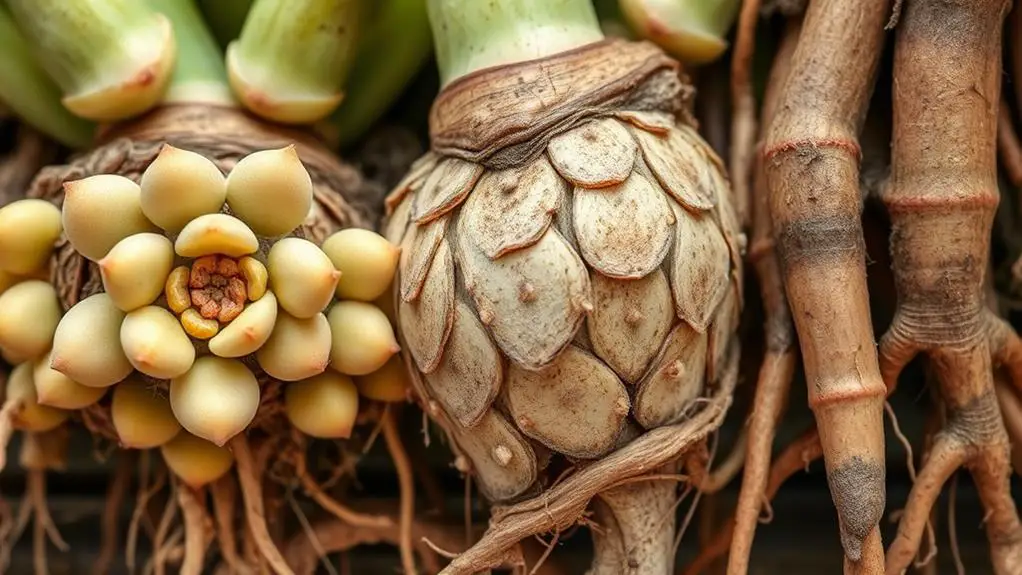
Distinguishing between healthy root nodules and harmful nematode infestations is vital for maintaining your succulent's health. Root nodules are typically circular and firm, while root nematodes exhibit irregular shapes and can even spread to the stems of your plant. When cut open, healthy root nodules appear white, indicating beneficial rhizobia that help with nitrogen fixation. In contrast, nematodes can show pink-colored wounds.
To help you differentiate, here's a table summarizing the differences:
| Feature | Root Nodules | Root Nematodes |
|---|---|---|
| Shape | Circular and firm | Irregular and spreading |
| Location | Soil-covered root regions | Can spread to stems |
| Color when cut open | White | Pink-colored wounds |
| Effect on nutrient absorption | No hindrance | Significant damage |
| Role | Nitrogen fixation | Root decay |
Root nodules generally don't hinder nutrient absorption, while nematodes cause discoloration, swelling, or distortion. Regular inspection is important. Identifying these differences helps avoid pest infestations and guarantees a healthy root system for your succulent plants. If your plant shows signs of stress or poor growth, check the roots to spot these issues early. Remember, healthy nodules contribute positively, while nematodes lead to root decay and other problems.
Treatment Methods
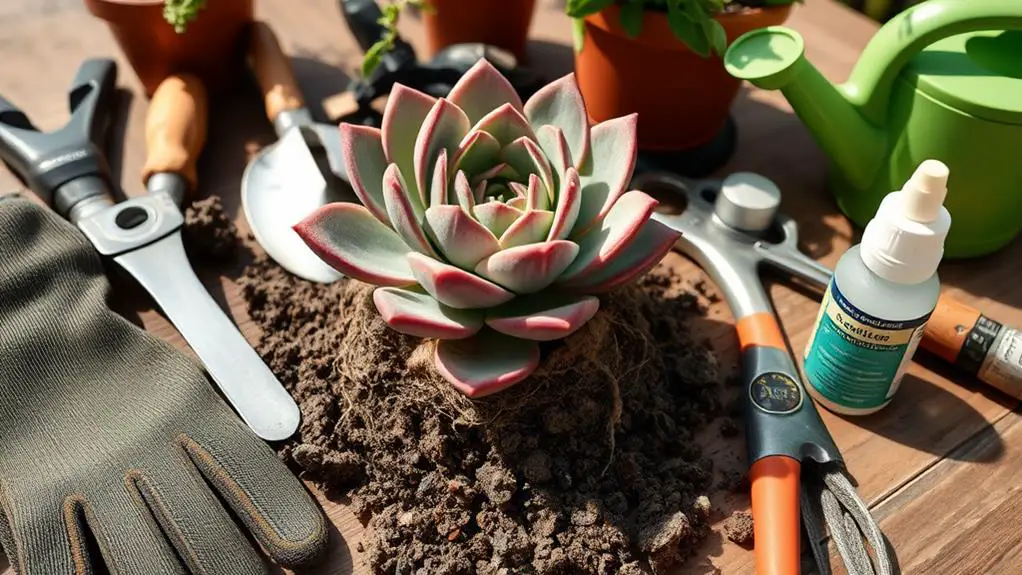
Treating root nodules in succulents involves careful and deliberate steps to guarantee the plant's recovery. First, use sterilized tools to carefully remove any affected roots. This prevents further infection and promotes the plant's healing.
After trimming, rinse the remaining succulent head to eliminate any residual pathogens. Allow it to heal in a well-ventilated area for 2-3 days before replanting.
It's essential to disinfect pots and tools by soaking them in water above 65°C for 10 minutes. This step helps prevent the spread of pests and diseases when you replant your succulents.
Use fresh, well-draining succulent soil to provide ideal conditions for recovery and to help your plants stay healthy and thriving.
To guarantee your succulents remain in good health, regularly monitor the plant's health and inspect root systems for any signs of nematode infestation or other complications.
Here are the steps to treat root nodules:
- Trim Affected Roots: Use sterilized tools to remove unhealthy roots.
- Disinfection: Soak pots and tools in hot water to kill pests and pathogens.
- Use Fresh Soil: Replant in well-draining succulent soil for the best recovery.
Prevention Strategies
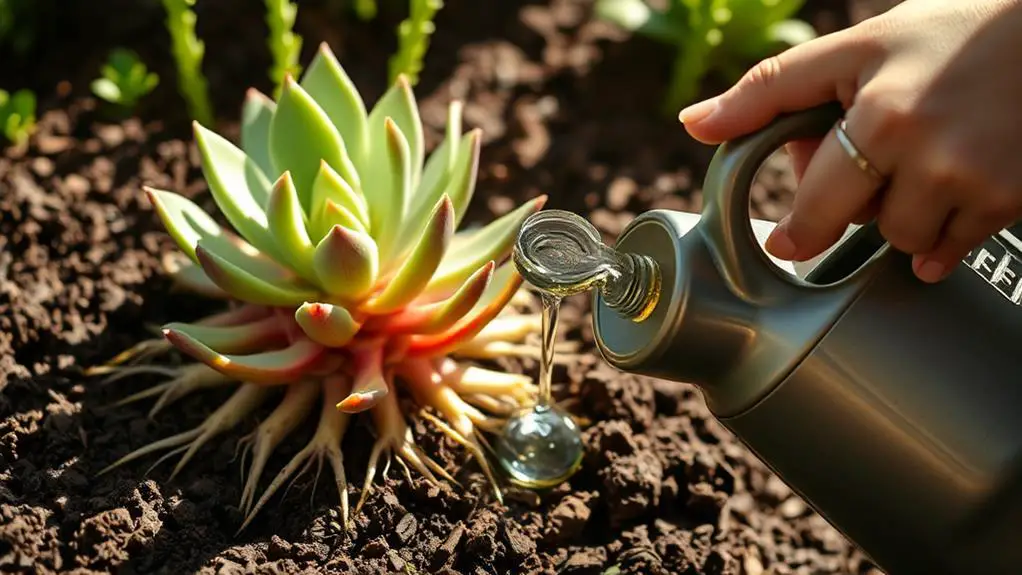
When it comes to preventing root nodules in succulents, taking proactive measures can make all the difference in maintaining plant health. One of the best prevention strategies is using sterilized garden soil when potting your succulents. This reduces the risk of introducing pathogens that could lead to root nodules and nematode infestations.
Next, avoid over-fertilization. Too much organic and nitrogen fertilizer can promote unhealthy growth, making your succulents more susceptible to root nodules. Stick to a balanced fertilizing routine to keep your plants healthy.
Regular soil inspection is also essential. Always check the soil and root systems of new succulents before adding them to your collection. This guarantees they're free from pests and diseases that could harm your other plants.
Implementing a proper watering schedule is another key prevention strategy. Allow the soil to dry out completely between waterings. This prevents conditions that favor root nodule development and rot.
Lastly, consider using a diluted fungicide or nematicide solution during the growing season. This can help prevent root nodule and nematode problems before they start.
Frequently Asked Questions
How Do You Tell the Difference Between Healthy Roots and Root Rot in Succulents?
You can tell the difference by looking at the color and texture of the roots. Healthy roots are firm, white, and plump. Roots affected by rot are dark brown or black and mushy. Regular monitoring helps.
What Does Root Rot in Succulents Look Like?
You'll notice root rot in succulents by dark brown or black roots, mushy tissue, and yellowing or pale leaves. The plant may collapse or drop leaves. Identifying these signs early helps you act quickly to save your plant.
How Do You Fix Aerial Roots on Succulents?
To fix aerial roots on succulents, give them bright, indirect sunlight and adjust watering to maintain consistent soil moisture. Prune any aerial roots, use well-draining soil, and consider repotting in a larger container for stability.
What Does a Root Bound Succulent Look Like?
A root-bound succulent looks stunted, with roots circling the pot edges and poking out of drainage holes. You'll notice yellowing leaves or wilting. The plant might seem top-heavy and unstable, indicating overcrowded roots needing repotting.
Conclusion
By keeping an eye on your succulent's root nodules and knowing how to treat them, you're setting your plants up for success. Remember to check for firm, consistently colored nodules and act quickly if you notice any distress signs. Use sterilized tools, rinse your plant, and let it heal. Stick to preventive measures like using clean soil and watering properly. You've got this, and your succulents will thank you for the care you put in!


